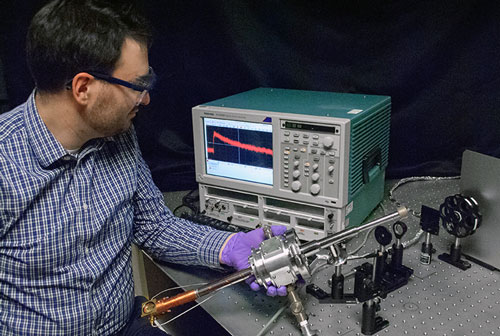| Posted: Sep 14, 2015 |
Ultrafast photodetectors allow direct observation of multiple electrons generated by a single photon
(Nanowerk News) One of the big benefits of the tiny semiconductor pieces known as quantum dots is that they can crank out multiple electrons from a single photon, a feature called “carrier multiplication,” which could lead to cheap and highly efficient solar cells and new types of photo and radiation detectors.
|
|
Detecting and quantifying this multiplication process in working devices has proven challenging, however, as noted by Victor Klimov, director of the Center for Advanced Solar Photophysics (CASP) at Los Alamos National Laboratory.
|
 |
| Andrew Fidler of Los Alamos National Laboratory examines an ultrafast photodetector used to measure quantum dot carrier multiplication in real time.
|
|
“The key advance is a newly developed capability which allows us to follow the fate of photogenerated electrons on ultrafast timescales directly in the photocurrent measurements. Research in our team and elsewhere had previously focused on using optical spectroscopy for detecting carrier multiplication and quantifying its efficiency,” he said.
|
|
“It has remained unclear whether the efficiencies observed in spectroscopic measurements can be reproduced in a photocurrent of real-life devices. Our new study allows us to address this important question.”
|
|
The new technique involves monitoring photocurrent transients in specially engineered photodetectors that provide very high temporal resolution of only 50 picoseconds.
|
|
Jianbo Gao, the postdoctoral researcher working on this project and co-author of a new Nature Communications paper ("Carrier multiplication detected through transient photocurrent in device-grade films of lead selenide quantum dots"), said, “The measurements have become possible using newly developed photodetectors that incorporate quantum dots as a part of the device and that serve as its active photoconductive layer. Using an appropriate photodetector design in combination with ultrafast electronics, we have been able to resolve very short photocurrent spikes due to multiexcitons produced in a carrier multiplication process.”
|
|
Said Andrew Fidler, a Los Alamos Director’s postdoctoral fellow on the project, “A key difficulty with carrier multiplication is quickly extracting photogenerated carriers before they recombine.” In the case of multiexcitons, this recombination process is governed by so-called Auger decay, which is characterized by extremely short, picosecond time scales. “Using our new photodetectors, we have shown that by applying an appropriate chemical treatment to the quantum dot outer layer, we can extract charges from the quantum dot prior to their recombination. This proves that carrier multiplication is a viable approach for enhancing photocurrent of real-life devices.”
|

